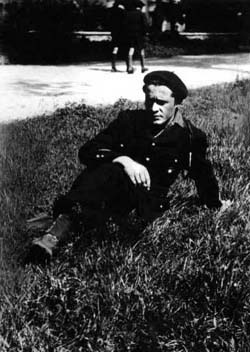The highest battle in Europe -
French Alps, upper Maurienne, Savoie, France, April 1945
Click here for the French original version

|
| Sergeant Roger Cerri, 1945
|
Battle fought by the 4th company of the 6th chasseurs alpins battalion (Sergeant Roger Cerri and Senior Corporal Jean Gilbert were members of this unit).
In April 1945, the German mountain light infantry and Italian Fascists paratroopers still occupied the alpine ridge between France and Italy, notably in the upper Maurienne in the key sector of Mount Cenis. All the positions were held by crack units from the 5th German Mountain Division (principally the 3rd battalion of the 100.Gebirgsjäger-Regiment) and a company of the Italian Fascist Folgore Regiment : about fifteen hundred well trained, well-equipped soldiers with twenty howitzers and several heavy mortars. In the valley below, the 27th French Mountain Division, composed of former maquisards, brought three chasseurs alpins battalions into operation : about three thousand volunteers, not trained enough, badly equipped, but supported by forty-five field guns.
On the 5th of April 1945, in spite of frigid conditions, a bitter wind and icy snow, the French battalions launched an offensive against the plateau of Mount Cenis, main part of the enemy defense, which gives access to the Suse valley and Piedmont. The first target was to take hold of Mount Froid (2820 m) which commands the valley and was the corner stone of the German stronghold. Its summit, a narrow ridge seven to eight hundred meters, was shielded by three strong points : east and west blocks with two tumbledown casemates and a center block with a network of trenches. On the 5th of April, the 4th company of the 11th chasseurs alpins battalion succeeded in conquering the middle and the western strong points. The next day, after a fourth attack, the same unit seized the eastern block : Mount Froid fell finally into the French hands ! However, a long way from the supply base, the position was all the harder to hold under artillery fire because the enemy decided to reconquer it at all costs...
Fortunately, in the course of the 6th of April, a fresh supply of troops was sent up : parts of the 2nd company of the 11th BCA and particularly the whole 4th company of the 6th BCA. The soldiers, without skis or snowshoes, but with an excess of ammunition, reached the top after a very tiring climb in deep snow. In spite of these reinforcements, a noisy wind as well as a constant fog neutralized outposts'vigilance... A short time before midnight, after a violent shelling, an enemy detachment (one German company and two Italian platoons), composed of five groups, silently approached the eastern casemate : while three groups made a frontal attack, the two others tried to outflank the position. Apocalyptical scene with flashes of flare and tracer bullets, bursts of gunfire, mortar shells, grenades and Panzerfaust projectiles in a hell of a row... The small French garrison was overwhelmed and on the verge of being annihilated. Under the command of Chief Warrant Officer Jeangrand, a platoon of the 4th company of the 6th BCA (with Sergeant Roger Cerri and Senior Corporal Jean Gilbert) came immediately to the rescue...

|
| Insignia of the 13th battalion
|
In the engagement, Chief Warrant Officer Jeangrand, Warrant Officer Gay and a private were killed, three others wounded. All the groups withdrew under fire and took refuge in the center block. The attackers screamed and charged with submachine guns and hand grenades. The French chasseurs alpins defended themselves energetically. Facing a volley of bullets, the enemy had to step back, but it attacked quickly again and arrived at close range. Several French soldiers were killed or wounded, but the others, singing the Chant du départ, opened a running fire. As dawn was breaking, the attackers retired... Shortly afterwards, a snowstorm raged. It was freezing hard. Most men were exhausted, many men had frozen feet, the weapons were frozen... On the 9th of April, the 4th company of the 6th BCA was relieved at last...
After the failure of three counterattacks, the German command was resolved to evacuate the sector of Mount Cenis, but, at the highest level, Generaloberst von Vietinghoff, commander-in-chief of the German front in Italy, ordered to resist and to recapture Mount Froid at any price. So, with the help of important reinforcements from the Division, the Germans reconquered their position on the 12th of April 1945. Nevertheless, two weeks later, they received orders to leave the region.
Contributed by
Alain Cerri
Other Links:
The French Chasseurs Alpins battalions
The 13th Chasseurs Alpins battalion
5.Gebirgsdivision - 100.Gebirgsjäger-Regiment
Traditional battlefields
The area of this battle belongs to the oldest battlefields of Europe. 2163 years before the battle of Mount Froid another desperate struggle took place within just 30 kilometres. In 218 bc, the army of Hannibal was attacked by Gaulic tribes on their way through the alps. Under horrific losses they managed to win the pass and march on into history. Perhaps, in the year 4308, humanity will have made some more progress.

